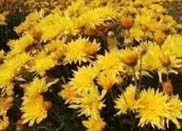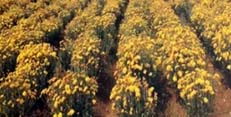cultivation practices
-
soil and climate
The ideal soil is a well-drained sandy loam with good texture and aeration. The soil should be neutral or slightly acidic with pH 6.5 to 7.0 having high organic content.
Most of the cultivars require shorter days for flower bud initiation and development and long day for better vegetative growth. It can be successfully grown upto an altitude of 1200 m elevation and relative humidity of 70-90% is optimum.
-
Propagation
Chrysanthemum is propagated vegetatively either through suckers or terminal cuttings.
suckers:
Chrysanthemum Suckers arise from the underground stem which are separated and planted in prepared nursery beds. Regular pinching is performed in these plants for vigorous and profuse branching. Some of these stock plants are used for preparation of cuttings.
-
planting

The field is thoroughly ploughed before planting. After ploughing of FYM @ 20 tons per hectare is applied at the time of field preparation. Planting on ridges is recommended to avoid excessive moisture during the rainy season. Rooted cuttings are planted at a spacing of 30x30cm in the month of July in northern parts of India and in February and March in most of the southern states.
-
Plant growth regulators
Crop growth regulation and flowering can be modified or controlled by use of growth regulators. Flower quality and yield can be improved by the use of regulators. Spraying GA3 (50 ppm) at 30, 45 and 60 days after planting increases the flower yield.
Irrigation
Plant requires frequent and thorough irrigation. Irrigation is given twice a week in the first month and subsequently at weekly intervals as per the prevailing weather conditions.
-
Manuring and fertilizer management
Chrysanthemum requires large amount of both nitrogen and potassium. Nitrogen is required at early stage and need phosphorus throughout the growth period. As the bud appears, the proportion of potassium should be increased and N should be reduced.
weed control
Weeding and hoeing are generally done manually and timely weeding is given. Also, soil is made loose porous to provide aeration.
-
Terminal Cuttings:

Chrysanthemum Suckers arise from the underground stem which are separated and planted in prepared nursery beds. Regular pinching is performed in these plants for vigorous and profuse branching. Some of these stock plants are used for preparation of cuttings.
-
Pinching
Pinching refers to the removal of growing tips of the plant to induce the growth of vegetative laterals. It reduces the plant height, promotes axillary branching, delays flowering and helps in breaking rosetting. Pinching is performed both in suckers and in cuttings. It is normally done with thumb and forefinger. Pinching is done when the plants reach a height of 15-20 cm with 3-4 pairs of leaves. Two types of pinching are performed. In soft pinching the soft tip of the shoot along with 2-3 open leaves is removed while in hard pinching a longer portion upto hard shoot is removed.
-
Disbudding
This operation is mostly performed for large flowered and decorative types. The largest terminal bud is retained and all axillary buds are removed. These operations are essential for three blooms/ plant or one bloom/plant and in the maintenance of high-quality flowers.
De-suckering
New suckers continue to develop from base of plants. For proper and vigorous growth of plants, suckers are removed from time to time.
-
Harvesting

The correct stage of harvesting depends upon the cultivar, marketing and purposes etc. The flowers are harvested 3 months from the date of planting at an interval of 4 days. For floral decoration and garlands, fully opened flowers are plucked with or without the peduncle. Flowers are packed loose in bamboo baskets or gunny bags and sent to retail markets for sale.

